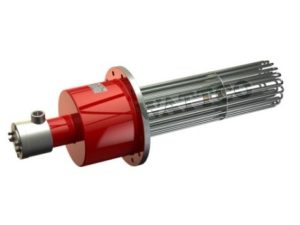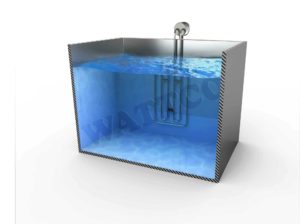A Closer Look at Immersion Heaters for Tanks
Last updated on September 21st, 2020 at 06:25 pm
Heating storage tanks is an important application of electric immersion heaters. Tank heating is a process for a number of industries. Food & Beverage, Chemical, Oil & Gas, and Agriculture all rely on tank heating. The most common types of immersion heaters for tanks include:
- Flange Heaters
- Screw Plug Heaters
- Over-The-Side Heaters
Flange Hea ters for Tanks
ters for Tanks
Flanged heaters are among the most widely used industrial heaters. They use bent tubular elements connected to a flange. A variety of available materials make flanges suitable for heating all sorts of materials. Stainless steel flange heaters, for instance, are able to resist corrosive mediums. They can be customized for specific kilowatt ratings, temperature ranges, and sheath materials.
Screw Plug Heaters for Tanks
Screw plug heaters are similar to flange heaters. They are fully submersible and can be fitted for a wide variety of applications. There are a few ways they differ. For one, screw plug heaters are typically used in smaller tanks than flange heaters. Also, most screwplug heaters typically use 0.315 inch hairpin tubular elements instead of 0.430 inch tubular elements allowing them to fit in small openings. Another is the way they connect to the tank. The screw plug heater elements are screwed directly into the tank. Along with their explosion-proof enclosures, this makes them ideal for flammable mediums or mediums that require additional safety measures. Being connected on the inside allows for the tank’s contents to be shielded from the exterior.
Over-The-Side Heaters for Tanks
 Over-the-side immersion heaters are a little more different from flanges and screw plug heaters. Most notably, is the way they are installed. They are fitted over the side of tanks and are usually positioned in the upper portion of tanks. This makes them ideal for heating when the only tank access is from the top. Another benefit is access. They can be easily removed for quick maintenance or after a target temperature has been achieved. This also allows for use of the same heater across multiple tanks. Over-the-side heaters can be custom shaped to fit specific tanks. As well, materials, wattages, and temperature ranges can be customized to match specific requirements.
Over-the-side immersion heaters are a little more different from flanges and screw plug heaters. Most notably, is the way they are installed. They are fitted over the side of tanks and are usually positioned in the upper portion of tanks. This makes them ideal for heating when the only tank access is from the top. Another benefit is access. They can be easily removed for quick maintenance or after a target temperature has been achieved. This also allows for use of the same heater across multiple tanks. Over-the-side heaters can be custom shaped to fit specific tanks. As well, materials, wattages, and temperature ranges can be customized to match specific requirements.
Choosing the Right Immersion Heaters for Tanks
Picking the right immersion heater for use in tanks is directly dependent on the application. A tank with the need for explosion-proof housing, for example, would not be suited to an over-the-side immersion heater. There are other considerations as well, such as the sensors, controls, and materials. The material used is also dictated by the application. Titanium, for example, would not be an appropriate sheath material for saltwater applications. We take a look at a couple of instances where we had to choose between types immersion heaters for tanks. In each case, the specific needs of the application determined the best electric heater option.
Immersion Heater Tanks for Freeze Protection in Alaska
We were tasked with providing freeze protection for a wastewater and desalination plant in Alaska. Freeze protection is an important function of electric immersion heaters. It keeps operations functioning efficiently as well as protecting mediums and equipment. In this case, the priorities were:
- Maintaining temperature above freezing
- Monitoring water levels to prevent damage to linings
The challenge was to find the best electric immersion heater for use in cold weather. Alaskan winters are 6 months long and cold. The average annual temperature is 37०F (2.78०C). On a cold day, temperatures could easily drop to freezing with little notice. The solution ended up being to use flanged heaters. In a closed off tank, a flange or screw plug heater would need to be used. The application was large enough that a screw plug heater would not be as efficient as a flange. The flange materials would also impede corrosion. They are commonly used in industrial applications for freeze protection. The flanged heater was equipped with storage tank control sensors. These maintain temperatures and monitor water levels. The temperature was set to 37०F. That way it met the average local temperature, and thus would reduce energy waste.
Immersion Heater Tanks for Food Processing
Freeze protection is one of many uses for immersion heaters in tanks. Next, we look at the instance of a food processing application for Sescof Manufacturing Inc. They needed to heat 200 gallon tanks for food processing. They had to be heated from room temperature to temperatures of 180०F to process food. Our recommendation was screw plug heaters. They are capable of heating foods and liquids quickly and without direct contact with the foods being processed. This is important, due to sanitary considerations. The screw plug heaters for these tanks were equipped with thermocouples to prevent the tanks from overheating.
How to Choose Immersion Heaters for Tanks
It is crucial to get the right tank immersion heater for your application. Each application comes with its own specific set of requirements. The better you meet these specific needs the more efficient your electric immersion heater will be. For help choosing which is right for you, or to get an immersion heater quote, c
